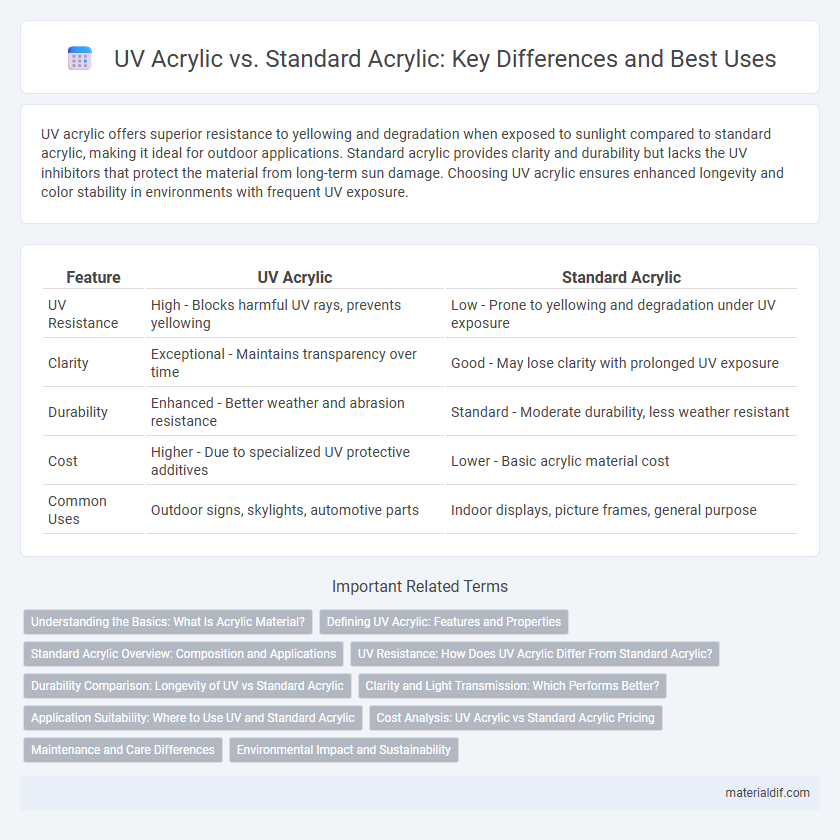UV acrylic offers superior resistance to yellowing and degradation when exposed to sunlight compared to standard acrylic, making it ideal for outdoor applications. Standard acrylic provides clarity and durability but lacks the UV inhibitors that protect the material from long-term sun damage. Choosing UV acrylic ensures enhanced longevity and color stability in environments with frequent UV exposure.
Table of Comparison
| Feature | UV Acrylic | Standard Acrylic |
|---|---|---|
| UV Resistance | High - Blocks harmful UV rays, prevents yellowing | Low - Prone to yellowing and degradation under UV exposure |
| Clarity | Exceptional - Maintains transparency over time | Good - May lose clarity with prolonged UV exposure |
| Durability | Enhanced - Better weather and abrasion resistance | Standard - Moderate durability, less weather resistant |
| Cost | Higher - Due to specialized UV protective additives | Lower - Basic acrylic material cost |
| Common Uses | Outdoor signs, skylights, automotive parts | Indoor displays, picture frames, general purpose |
Understanding the Basics: What Is Acrylic Material?
Acrylic material is a transparent thermoplastic known for its clarity, weather resistance, and durability, commonly used as a lightweight alternative to glass. UV acrylic incorporates ultraviolet light stabilizers that protect against yellowing and degradation when exposed to sunlight, enhancing longevity for outdoor applications. Standard acrylic lacks these UV inhibitors, making it more suitable for indoor use where exposure to UV radiation is minimal.
Defining UV Acrylic: Features and Properties
UV acrylic is engineered with a specialized ultraviolet (UV) resistant coating that protects it from yellowing and degradation caused by prolonged sun exposure. Its enhanced durability and clarity make it ideal for outdoor signage, protective screens, and display cases. Standard acrylic, while offering excellent optical clarity and impact resistance, lacks this UV protective layer, making it more prone to discoloration and brittleness over time when exposed to sunlight.
Standard Acrylic Overview: Composition and Applications
Standard acrylic, composed primarily of polymethyl methacrylate (PMMA), offers excellent optical clarity and weather resistance, making it a popular choice for a variety of applications. Its versatility allows widespread use in signage, display cases, windows, and protective barriers where durability and transparency are essential. This material is favored for standard indoor and outdoor projects due to its ease of fabrication and cost-effectiveness compared to UV acrylic variants.
UV Resistance: How Does UV Acrylic Differ From Standard Acrylic?
UV acrylic contains special UV inhibitors that significantly enhance its resistance to ultraviolet radiation, preventing yellowing and degradation over time. Standard acrylic lacks these additives, making it more susceptible to UV damage and reduced clarity when exposed to prolonged sunlight. This difference makes UV acrylic ideal for outdoor applications requiring long-term durability and color retention.
Durability Comparison: Longevity of UV vs Standard Acrylic
UV acrylic exhibits superior durability compared to standard acrylic due to its enhanced resistance to yellowing and surface degradation caused by prolonged exposure to ultraviolet light. Standard acrylic tends to degrade faster under UV exposure, leading to brittleness and diminished clarity over time. The longer lifespan of UV acrylic makes it ideal for outdoor applications and environments with high UV radiation.
Clarity and Light Transmission: Which Performs Better?
UV acrylic outperforms standard acrylic in clarity and light transmission due to its enhanced UV resistance, which prevents yellowing and maintains optical transparency over time. Standard acrylic typically exhibits slight degradation when exposed to sunlight, leading to reduced light transmission and clarity. For applications requiring long-term clarity and maximum light passage, UV acrylic is the superior choice.
Application Suitability: Where to Use UV and Standard Acrylic
UV acrylic is ideal for outdoor applications such as signage, skylights, and protective barriers due to its superior resistance to ultraviolet light, preventing yellowing and degradation over time. Standard acrylic is suitable for indoor uses like picture frames, display cases, and furniture components where exposure to UV rays is minimal and cost-effectiveness is a priority. Choosing UV acrylic enhances durability in sun-exposed environments, while standard acrylic meets demands for clarity and ease of fabrication in controlled indoor settings.
Cost Analysis: UV Acrylic vs Standard Acrylic Pricing
UV acrylic typically commands a higher price than standard acrylic due to its enhanced durability and resistance to yellowing caused by ultraviolet light exposure. Standard acrylic offers a more budget-friendly option for applications where UV protection is not critical, making it suitable for indoor uses or short-term installations. Cost analysis should weigh the long-term benefits of UV acrylic's extended lifespan against the initial savings provided by standard acrylic.
Maintenance and Care Differences
UV acrylic offers superior resistance to yellowing and surface degradation compared to standard acrylic, reducing the frequency of cleaning and maintenance. Its enhanced UV protection minimizes the need for harsh chemicals, allowing for gentler cleaning methods that prolong clarity and durability. Standard acrylic requires more frequent polishing and careful handling to prevent scratches and discoloration from UV exposure.
Environmental Impact and Sustainability
UV acrylic offers enhanced durability and resistance to ultraviolet light, reducing the need for frequent replacements and minimizing environmental waste compared to standard acrylic. Standard acrylic often degrades faster under UV exposure, leading to increased material consumption and higher carbon footprint due to more frequent production cycles. Choosing UV acrylic supports sustainability by extending product lifespan and lowering overall environmental impact through reduced resource use.
UV Acrylic vs Standard Acrylic Infographic

 materialdif.com
materialdif.com